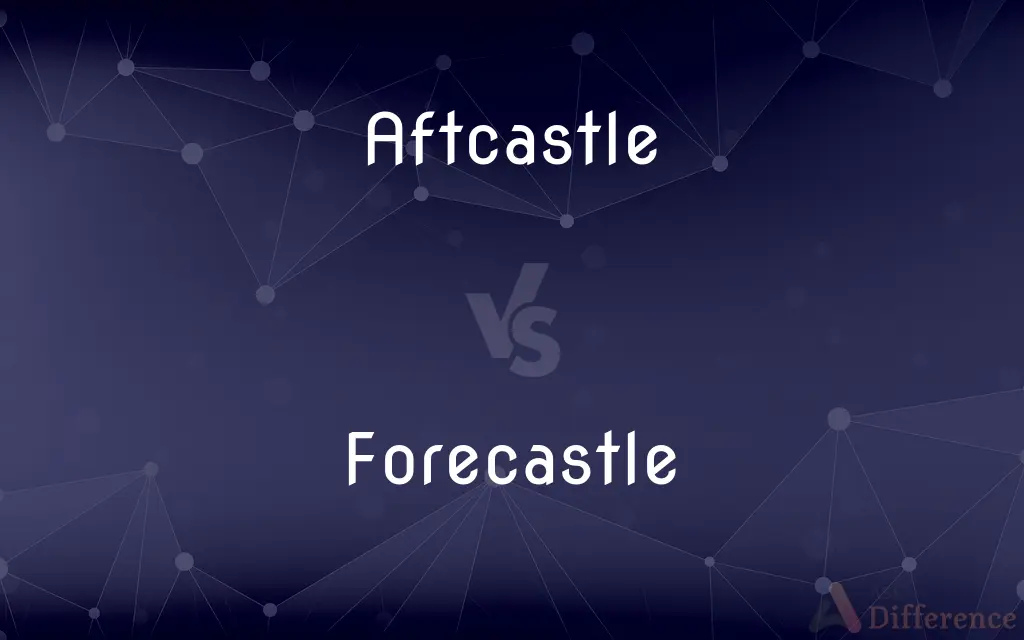Aftcastle vs. Forecastle — What's the Difference?
By Tayyaba Rehman & Fiza Rafique — Updated on April 27, 2024
Aftcastle is located at the rear of a ship, offering protection and command features, whereas forecastle is positioned at the front, primarily for crew accommodations and storage.

Difference Between Aftcastle and Forecastle
Table of Contents
ADVERTISEMENT
Key Differences
The aftcastle, traditionally known as the sterncastle, is situated at the back of a ship. It historically served as a defensive platform and command center during naval battles. On the other hand, the forecastle is located at the front of the vessel and was primarily used for sailors’ living quarters and the storage of sailing equipment and anchor.
Aftcastle areas are often elevated, providing an excellent vantage point for navigation and overseeing the entire ship. In contrast, forecastles are generally lower to the deck and may be partly or entirely under the upper deck, which shelters them from ocean spray and provides stability.
In modern naval architecture, the aftcastle might still be used for command functions, including housing the ship’s wheelhouse or navigation center. Whereas, the forecastle remains utilitarian, often accommodating machinery like windlasses, capstans, and sometimes crew facilities.
The design and structure of aftcastles vary significantly across different types of ships, from ornate and expansive on large vessels to minimal on smaller ones. Meanwhile, forecastles are more uniformly designed, focusing on practicality and maximizing space for crew activities and equipment storage.
On sailing ships, the aftcastle was also a place of social gathering for officers, reflecting its status and strategic importance. The forecastle, however, was cramped, often damp, and less comfortable, reflecting the hierarchical divide on maritime vessels.
ADVERTISEMENT
Comparison Chart
Location
At the rear of the ship
At the front of the ship
Main Function
Command and control, defense
Crew accommodations, storage
Elevation
Usually elevated for visibility
Lower, often partially under the deck
Modern Usage
Navigation center, social area
Houses machinery, sometimes crew areas
Comfort and Status
More spacious and comfortable for officers
Less comfortable, utilitarian for crew
Compare with Definitions
Aftcastle
A place for ship command and social gatherings among officers.
Officers discussed their strategy in the aftcastle.
Forecastle
Primarily used for crew living quarters and storage.
The forecastle was cramped but housed all the crew's essentials.
Aftcastle
In modern ships, often includes the wheelhouse or navigation area.
The ship’s controls are located in the aftcastle.
Forecastle
The front section of a ship, below the upper deck in many cases.
The crew prepared the sails stored in the forecastle.
Aftcastle
Historically, a defensive feature in naval vessels.
The aftcastle’s walls were fortified to withstand attacks.
Forecastle
Less comfortable, reflecting lower crew status.
Life in the forecastle was tough but bonded the sailors.
Aftcastle
Can vary in size and ornamentation depending on the ship’s design.
The luxurious yacht featured a lavishly decorated aftcastle.
Forecastle
Features equipment like windlasses and capstans.
The noisy windlass in the forecastle kept the crew awake.
Aftcastle
The rear section of a ship, elevated for better view and protection.
The captain stood on the aftcastle, surveying the horizon.
Forecastle
Modern designs focus on practicality and efficiency.
The ship’s forecastle was efficiently organized to maximize space.
Aftcastle
Raised part of the upper deck at the stern of a ship.
Forecastle
The forecastle ( (listen) FOHK-səl; contracted as fo'c'sle or fo'c's'le) is the upper deck of a sailing ship forward of the foremast, or, historically, the forward part of a ship with the sailors' living quarters. Related to the latter meaning is the phrase "before the mast" which denotes anything related to ordinary sailors, as opposed to a ship's officers.
Forecastle
The forward part of a ship below the deck, traditionally used as the crew's living quarters.
Forecastle
The section of the upper deck of a ship located at the bow forward of the foremast.
Forecastle
A superstructure at the bow of a merchant ship where the crew is housed. See Usage Note at boatswain.
Forecastle
(nautical) A raised part of the upper deck at the front of a ship.
Forecastle
(nautical) Crew's quarters located at the forward part of a ship.
Forecastle
A short upper deck forward, formerly raised like a castle, to command an enemy's decks.
Forecastle
Living quarters consisting of a superstructure in the bow of a merchant ship where the crew is housed
Common Curiosities
Can you find the wheelhouse in the forecastle of modern ships?
No, the wheelhouse is typically located in the aftcastle for better visibility and control.
Why was the aftcastle important in historical naval battles?
It provided a strategic vantage point and protective enclosure for commanding officers.
How does the location of the forecastle affect its function?
Positioned at the front, the forecastle is ideal for housing crew and equipment necessary for ship operations.
What type of facilities are found in a forecastle today?
Modern forecastles often contain machinery and sometimes crew living spaces.
What kind of activities occur in the forecastle of a merchant ship?
It's primarily used for storage and as a workspace for handling anchors and cables.
What makes the aftcastle a preferred location for social gatherings on ships?
Its relative comfort, privacy, and views make it suitable for officer gatherings.
What is the main purpose of an aftcastle on a ship?
The aftcastle serves as a command center and defensive platform.
What materials are used in constructing an aftcastle?
Depending on the ship’s design, materials range from wood on historical ships to modern steel and composites.
How does the design of the aftcastle impact ship stability?
Its elevation can affect the ship's center of gravity and stability, requiring careful architectural planning.
Are there modern ships that lack a forecastle?
Some streamlined, high-speed vessels may minimize or integrate the forecastle into the main hull design.
Is the aftcastle accessible to all crew members?
Access might be restricted, especially if it contains navigation equipment and officer quarters.
Do all ships have a distinct aftcastle and forecastle?
Most large ships do, but the structure and distinction might vary in smaller vessels.
How did the use of the forecastle evolve over time?
Initially for defense, it transitioned primarily to crew accommodations and storage.
How does the function of the aftcastle differ between military and commercial ships?
In military ships, it’s often geared towards strategic command, whereas in commercial ships, it might focus more on navigation and sometimes leisure spaces.
How is the safety of the forecastle ensured during rough seas?
Its position under the upper deck and robust construction help shield it from harsh elements.
Share Your Discovery

Previous Comparison
Aspect vs. Factors
Next Comparison
Size vs. DimensionAuthor Spotlight
Written by
Tayyaba RehmanTayyaba Rehman is a distinguished writer, currently serving as a primary contributor to askdifference.com. As a researcher in semantics and etymology, Tayyaba's passion for the complexity of languages and their distinctions has found a perfect home on the platform. Tayyaba delves into the intricacies of language, distinguishing between commonly confused words and phrases, thereby providing clarity for readers worldwide.
Co-written by
Fiza RafiqueFiza Rafique is a skilled content writer at AskDifference.com, where she meticulously refines and enhances written pieces. Drawing from her vast editorial expertise, Fiza ensures clarity, accuracy, and precision in every article. Passionate about language, she continually seeks to elevate the quality of content for readers worldwide.
















































